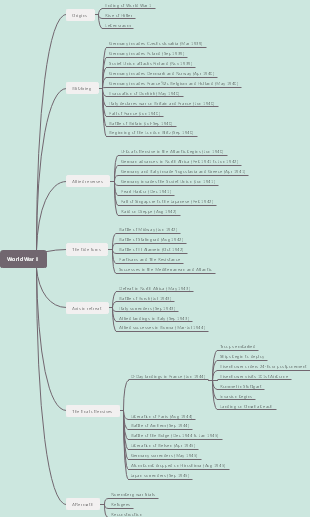MindMap Gallery History of Mexico
- 924
- 3
- 1
History of Mexico
It is a mind map of Mexico's history. It records the histroy from AD 250 to 20 century.
Edited at 2021-03-02 07:05:57- History of Montreal
Here is a mind map concerning the history of Montreal. In 19th century, the population in Montreal was around 58000 and it kept on growing quickly,
- Fun facts about Osaka
Here is a mind map concerning the fun fact about Osaka, which is the third-largest in Japan. Besides, Osaka is popular because of its underground shopping mall.
- History of Osaka
Here is a mind map about the history of Osaka. From the 15th century to the 19th century Osaka grew out to become a center of economy and a well-known major city of Japan.
History of Mexico
- History of Montreal
Here is a mind map concerning the history of Montreal. In 19th century, the population in Montreal was around 58000 and it kept on growing quickly,
- Fun facts about Osaka
Here is a mind map concerning the fun fact about Osaka, which is the third-largest in Japan. Besides, Osaka is popular because of its underground shopping mall.
- History of Osaka
Here is a mind map about the history of Osaka. From the 15th century to the 19th century Osaka grew out to become a center of economy and a well-known major city of Japan.
- Recommended to you
- Outline
History of Mexico
1855 – 1872
Limiting of the landholdings and power of the catholic church by the liberal reforms in the LA Reforma period.
1864 – 1867
Sub TopiArchduke Maximilian of Austria is introduced as head by France and moderate landowners, however is overturned and executed by Republican renegades.
1910 – 1920
Porfirio Diaz's dictatorship ends with the Mexican revolution and a constitutional government is established.
1916 – 1917
Indecisive US invasion against revolutionary leader Francisco Pancho Villa.
1920
Followed by a decade of uncertainty the President Venustiano Carranza gets murdered.
1929 – 1934
In 1929 the former president Plutarco Elias Calles established the Institutional Revolutionary Party (PRI), which ruled the government for 71 years.
1960 – 1968
The uproar among laborers and workers over unequal distribution of wealth is suppressed. In 1968, the students’ show in Mexico City during the Olympic Games was terminated by security.
1846 – 1848
Mexican-American War closes with Mexico being compelled to sell its northern areas (counting modern-time California, Nevada, New Mexico, Arizona, and Utah) to the US.
1836
The former region of Texas, at this point progressively populated by English-speaking Americans, withdraws after a war, proceeding to join the United States nine years’ after.
1824
Mexico becomes the federal republic. Central American provinces separate, becoming Honduras, Costa Rica, Nicaragua, Guatemala, and El Salvador.
1810 – 1821
War of Independence finishes with the making of the short-living Mexican Empire, which incorporates Central America toward the southern boundary of Costa Rica in the modern age.
1521 – 1820
The viceroyalty of New Spain forms part with Mexico.
1519 – 1521
Spain’s conquest begins with the small Spanish army that was led by Hernan Corte’s landing at the Veracruz. In 1521 along with local anti-Aztecs Corte’s men captivated the capital Tenochtitlan (Mexico is the modern world).
1428 – 1521
The most recent of a long line of native civilizations, the Aztec Empire - a union of Nahuatl-speaking city-states driven by Tenochtitlan - builds up authority over central Mexico.
10th – 16th century
Renewed Maya civilization blooms in the northern Yucatan peninsula, making significant urban communities like Uxmal and Chichen Itza.
6th – 7th century
New people came flooding in central Mexico from the north, including Nahuatl speakers.
AD 0 – 500
The major religious and cultural focus of Teotihuacán thrives.
AD 250 – 900
Traditional Maya city-states prosper in the most distant south of current Mexico.
1976
Enormous reserves of offshore oil are found; the Cantarell field turns into the pillar of Mexico's oil creation.
1993
Parliament approves the North American Free Trade Agreement (Nafta) with Canada and the US.
1994
The Zapatistas and government conceded to greater autonomy for the native Mayans of Chiapas the next year.
1996 – 1997
The Popular Revolutionary Army (EPR) attacked the government that produced a revolt in the south in 1996.
2000
Vicente Fox of the conservative Alliance for Change wins the election for president.









